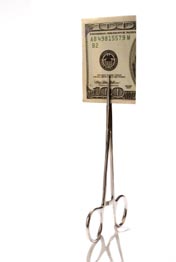A growing economy and an Obamacare spending surge, many suspected, had ended five years of moderate health-spending growth.
Early government figures showed medical-cost acceleration at the beginning of the year. “Health care spending rose at the fastest pace since 1980 in the first quarter as the new health insurance law prompted many more Americans to visit doctors and hospitals,” reported USA Today among others a month ago.
Not really.
The preliminary estimates that prompted the story were off. Hospital revenue fell in 2014’s first quarter compared with the final three months of 2013, the Census Bureau estimated Wednesday. So did revenue for medical labs and outpatient care.
Fees and insurance reimbursements collected by doctor offices — which some thought would be swamped by patients newly covered under the Affordable Care Act — fell by 6 percent from the fourth quarter to the first. (Those numbers aren’t adjusted for normal seasonal fluctuations, but total first-quarter health spending fell even after accounting for seasonal differences, JPMorgan Chase economist Dan Silver calculated in a note to clients.)
Even for a full year — from the first quarter of 2013 to the first quarter of 2014 — revenue for health care and social assistance rose only 2.9 percent.
“That’s just surprisingly low,” says Charles Roerhig, director of the Altarum Institute’s Center for Sustainable Health Spending. “This confirms the skepticism that has been expressed about the acceleration” suggested in earlier data.
Health spending, which has pressured taxpayers, consumers and employers by growing faster than the economy for decades, had slowed to a little less than 4 percent annual growth starting in 2009. Some thought it might pop to 6 percent this year, Roerhig said.
There’s still no guarantee that it won’t, even though many suspect that increasingly higher out-of-pocket expenses for consumers and the health law’s cost-control measures will help “bend the cost curve” for medicine over the longer term.
After all, Wednesday’s Census figures don’t include prescription drugs, some of which have put sharp pressure on government and insurance budgets in recent months.
May’s jobs report showed an uptick in health employment, which tends to track health spending. Especially bad winter weather probably had more than a little to do with revenue declines for doctors and hospitals in the first quarter. Wednesday’s data aren’t final.
And many people buying new plans under the health law didn’t enroll until the first quarter was almost over. Subsidized insurance sold through online exchanges was available starting Jan. 1, but millions didn’t sign up until just before (and a little after) the March 31 deadline.
That hardly allowed time to line up at the clinic.
Says Larry Levitt, Kaiser Family Foundation senior vice president: “Given the timing of when people are getting covered, I wouldn’t expect any bump until the second quarter.”
Let the debate continue.
Kaiser Health News is an editorially independent program of the Kaiser Family Foundation.







